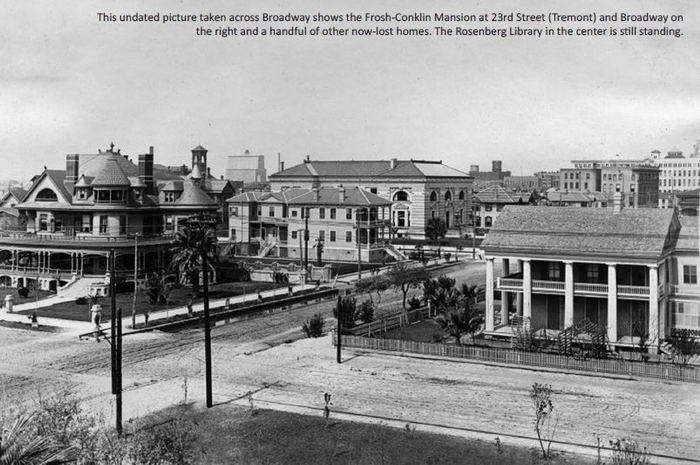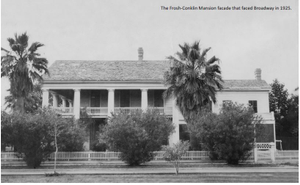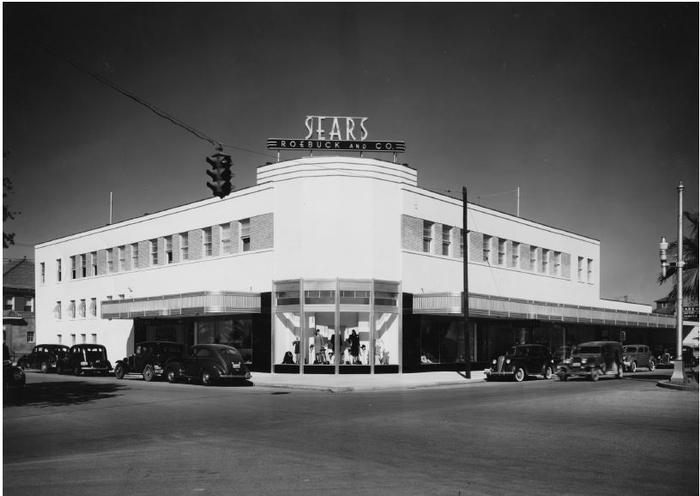Materials for the three-story, eleven-room home, including ten massive columns, were brought to Galveston from Maine by schooner. It was known for its wide porches, beautiful grounds, and elegant landscaping.
Designed to provide southern exposure to every room, its halls and stairways were on the north side. The floor plan included a perpendicular wing that featured the formal dining room, and the kitchen. Separate buildings on the grounds housed the servants and livestock, and huge iron vats used to render fat and make sausage during “hog killing time” sat at the back of
the property.

The impressive home’s owner, Lawrence Frosh, was a German immigrant who conducted a large wholesale merchandise business buying and selling everything from limes to pianos, and also did a large business supplying ships coming into the Galveston Harbor. His firm, L. Frosh & Co., was located on the northeast corner of Tremont and Strand for 35 years in a large two story frame structure, erected in the early-1840s. The waters of the bay came up to the back door, where ships could load or unload their goods. The area behind these buildings has long since been filled in and the shoreline extended.
Frosh married Jane Louise Francis, an English immigrant, Images courtesy of Rosenberg Libraryin Galveston in May 1845. The couple raised five children in their home: George, Elizabeth, John, Margaret, and Sarah, the latter known to family and friends as Sallie. The Frosh family was widely known for their hospitality, and Sallie and her mother had reputations as being charming hostesses.
In addition to his merchandising affairs, Frosh also owned multiple rental properties throughout Galveston, which benefitted his family for generations. When the prominent Galvestonian passed away at home in 1869 from “paralysis,” all of his financial matters were left in the hands of his wife. Fortunately, his widow was a savvy businesswoman and not only handled, but also
managed to increase, the family fortune in the following years.

From that time on, the women of the family handled most of the financial matters. It would normally have been the responsibility of the eldest son, George, but fate stepped in to prevent that.
George served in the 21st Texas Cavalry during the Civil War, and was wounded in a skirmish just preceding the Battle of Mansfield. When he recovered from his injury, he rejoined his regiment and remained with them until the end of the war.
When he returned home to Galveston, he was suffering from tuberculosis and exposure. By 1868, he was renting out his stores on the Strand and Avenue H, too ill to tend to his businesses.
He was sent to live in Boerne to battle the disease, but the change in location did little to ease his suffering, and he died in July 1884. His remains arrived in Galveston by train, and a funeral was held in the Frosh home. He was laid to rest at Trinity Episcopal Cemetery.
The Frosh’s daughter, Margaret, had married William McCall a few years earlier, but by 1880, she and their son, Frank Charles, were living in the Frosh family home. No mention of what happened to William can be found. Within several years, fire claimed several of the Frosh family’s business properties and rental cottages, causing large financial losses. In February 1870, fire destroyed
the Dargan & Tobyn building on the Strand, which sat on property owned by Mrs. Frosh, who had about $20,000 in losses. Dargan & Tobyn built a replacement, which still stands on the same lot.
Sallie, who had received a higher education at Hollins University, Virginia’s first chartered women’s college, held a highly regarded place in Galveston society and even performed soprano concerts in the 1880s to rave reviews. But with the death of her mother in July 1891, management of the family’s finances fell to Sallie.
The following year, her sister Margaret died after a long illness, leaving her son an orphan, and in 1893, Sallie, still single, became the administratrix of her sister’s estate, and the legal guardian of her nephew. She rented the family home - complete with furnishings - to a Mrs. Kohler, who occupied the mansion for at least two years. Sallie sold some of her father’s land holdings to George Sealy in 1896, and, rented the vacant mansion to a group that called themselves “The Bachelor’s Club.” A small silver placard on the door with the club name in black enamel letters caused so much talk around town that the Galveston Daily News investigated the group.
Far from the scandalous stories that had been circulating, the group was merely a gathering of single young gentlemen who held cotillions for themselves, their dates and chaperones.
Just one year later, the fully furnished home, described as one of the most desirable residences on the Island, was available for rent again.
In 1899, the then 42-year-old Sallie married William Thaddeus Conklin, nine years her senior, and the couple took up residence at the family mansion. That same year, her older brother, John, died.
At the turn of the century, two major events impacted Sallie’s life. First, she had the unenviable task of committing her troubled nephew to the St. Louis Insane Asylum, considered at the time to be a first-class hospital for the diagnosis and treatment of mental disorders.
Then the Great Storm of 1900, a category 4 hurricane that raked the island, devastated her hometown in Texas. An estimated 8,000 people were killed, at least 3,636 structures were destroyed, and some 10,000 residents left homeless. But the Frosh-Conklin Home survived.
According to records, the Conklin’s had three sons - William Thaddeus Conklin Jr., born June 7, 1901, “Baby Boy Conklin,” who died December 14, 1903, and is interred at Trinity Episcopal Cemetery; and Matthias Dayton Conklin, born April 11, 1905.
Sallie - who continued to run the family businesses and even built a new apartment complex on the lot just east of the family home - was widowed on Feb. 7, 1915, with the unexpected death of her husband. Three months later, on April 25, Sallie’s nephew died in the sanitarium.
His body was returned to Galveston, where he was buried at Trinity Episcopal Cemetery.
Sallie herself passed away in 1936, having lived on the same Galveston block her entire life. She, too, was buried in the family plot.
On Easter Sunday two years later, a window was dedicated in her honor at Trinity Episcopal Church. The stunning stained-glass was created by the famed Jacoby Studios in St. Louis, and is still visible in the sanctuary today as the only reminder of the once prominent Frosh family.
After a century-long presence on the main boulevard of Galveston, the Frosh-Conklin Home was demolished to make way for the construction of a Sears, Roebuck & Company store in 1940. That building was later occupied by the Salvation Army and is now the home of the Galveston Historical Foundation’s Architectural Salvage Warehouse.

Members of the Frosh and Conklin families were laid to rest in the Trinity Episcopal Cemetery. None of their descendants remain in Galveston.
The Frosh-Conklin Mansion facade that faced Broadway in 1936, the year Sallie Frosh Conklin passed away and just four years before it was demolished; TOP: This photo from 1945 shows The Sears Building that was constructed on the former site of the Frosh-Conklin Mansion and opened its doors for the first time on October 17, 1940.